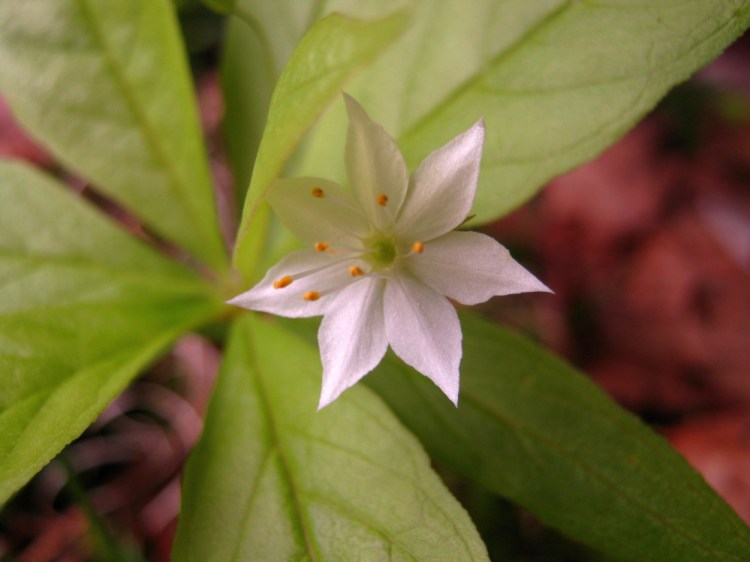On the edge of the woods, just off the deck of the house, a little grove of starflowers springs out of the sphagnum moss and wispy grass every May. It started out some years ago as maybe a half-dozen plants, and this week there are about 40 scattered around under the spruce-bough eaves.
They’re extraordinarily delicate-looking, with six or seven white petals in shapely points. The kind of flower that starts to make you uneasy about the idea that genetics is guided by accidents. The blossom tops a very slender stalk, one or two, sometimes three to a plant. Some guidebooks describe them as “fragile.” Behind the blossom, sort of like a cosmic background, is a layered whorl of dark green leaves, lance-shaped and as rich-looking as the flower.
Starflowers are perennials. An individual will grow and blossom up to three years — or so I’ve read and do in part believe it — from an underearth rhizome, a stem of the plant growing underground. The petals go by in a week or so, and the leaves yellow and fall off by midsummer, leaving one or two little seed capsules ripening on the tip of the stem. They wait out the winter for a cold treatment, then germinate in the fall of the second year.
The scientific name is Trientalis borealis, or sometimes Trientalis americana or Lysimachia borealis. The genus name “Trientalis” probably derives from Latin describing the plant’s height, about one-third of a foot, and “borealis” means “northern.” “Lysimachia” is, roughly, Latin for “loosestrife,” which older guidebooks give as the starflower’s family. More often it’s categorized in the primrose family.
I’m not really sure why, but I expected to find out starflowers have multiple medicinal uses, but it’s not mentioned in Peterson’s “Field Guide to Medicinal Plants and Herbs of Eastern and Central North America,” and one of the trolls repeated on Internet sites is that no one’s ever used it as a remedy for anything.
This turns out to be not exactly true. And the more I think about it, the further I go with it. Frank Speck, the great-grandfather of academic studies of Northeastern Native Americans, observed about 100 years ago in “Medicine Practices of the Northeastern Algonquians” that among the Montagnais Indians, “for general sickness, and incidentally for consumption, star anemone (Trientalis americana) otseqdtuq, ‘little light star’, also otemdna’n kwi’, ‘heart berry plant’, is steeped.” Another researcher found that Paiute Indians used the starflower’s juice as an eye treatment, and another that Ojibwas included the root in a mixture for a smoking scent to attract deer.
Anyway, I guess it’s no threat to pharmaceutical company profits and won’t get banned anytime soon. It’s listed as endangered in Georgia and Kentucky, and as threatened in Illinois and Tennessee.
In Maine, it’s pretty common, as far as I can tell, right in the kind of spot it’s growing at our place — cool woods just on the edge of the canopy, in from the sunstruck bluets and strawberry blossoms, out from the Canada mayflowers a bit farther into the shade.
The perfect place for our little grove.
We don’t see ourselves making a tea out of them, but on the other hand, a strong sense of evening develops out of those little stars. Always on the back end of spring, just as summer is about to drop but winter is not yet forgotten, they emerge one by one from the cosmic background radiation of new moss and infant timothy.
After a long winter of consumption by cold and dark, we’re breathing easy again. Just what stars dispense on still, fragrant summer evenings. This can’t be accidental.
Dana Wilde lives in Troy. His writings on the curiosities of his backyard are collected in “The Other End of the Driveway,” and he is a contributor to “Pluto: New Horizons for a Lost Horizon” now available from North Atlantic Books. You can contact him at naturalist1@dwildepress.net. Backyard Naturalist appears the second and fourth Thursdays each month.
Send questions/comments to the editors.




Comments are no longer available on this story